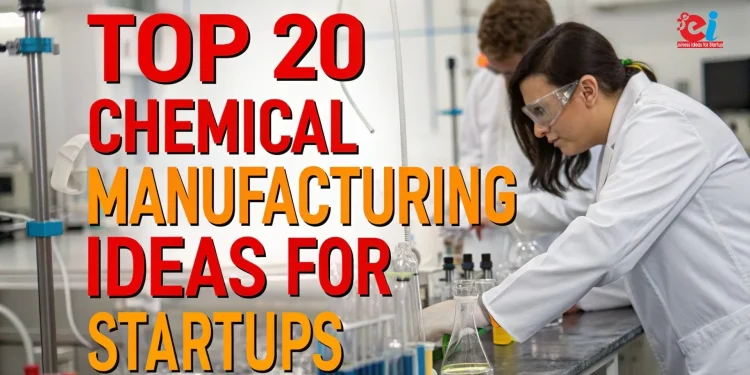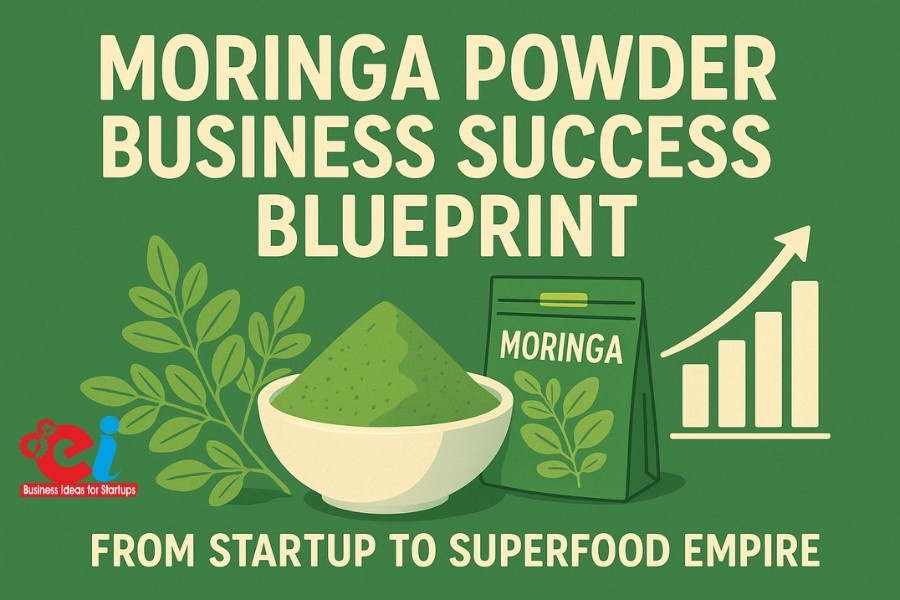India’s chemical manufacturing industry is valued at over USD 220 billion, and is expected to grow at one of the fastest rates globally, reaching USD 300 billion by 2027. The Indian government has been aggressive in pushing domestic chemical manufacturing as part of “Make in India” and “Atmanirbhar Bharat,” focusing on self-reliant imports.
This offers an untapped opportunity for entrepreneurs and startups to take advantage of high demand chemicals that are costly to import as they help grow domestic industry and exports.
Supported by data from trade relationships, I have highlighted the most lucrative opportunities in India to invest in chemical production for the year 2025, with accompanying reasons, statistics, and trends.
20 Profitable Chemical Manufacturing Ideas
1. Methanol
- Application: Forms the basis for hydrocarbons, for instance, formaldehyde, acetic acid, MTBE, and hydrogen.
- Why Produce: India’s Chemical Manufacturing imports over 2 million tonnes of methanol annually from Iran and Saudi Arabia. The country is striving to enhance domestic coal-to-methanol and green methanol projects.
- Startup Opportunity: Building small to medium methanol plants nearer to coal fleets or biomass feedstock areas.
Related: Setting Up a Small-Scale Methanol Gel Unit Under ₹25 Lakhs
2. Phenol & Acetone
- Application: Epoxy Resins, bisphenol A, etc., alongside major solvents pharmaceuticals based on phenol used.
- Why Produce: Methanol is still procured externally for over 60 percent of the country’s demands.
- Market Players: Demand is greater than supply, but Deepak Phenolics has capacity.
- Entrepreneur Angle: Available in India are integrated phenol-acetone plants from cumene using benzene and propylene.
Related: How to Start an Acetone Cyanohydrin Manufacturing Business
3. Toluene Diisocyanate (TDI)
- Application: Polyurethane foams, adhesives
- Current Scenario: Nearly 80-90% of needs are imported.
- Demand Growth: Infrastructure and automotive sectors are the drivers for polyurethane.
- Startup Insight: Ideal for chemical clusters, especially for collaboration with global licensors.
Related: Polyurethane (PU) Foam Production and Market Demand
4. Propylene Oxide
- Use: Surfactants, flexible polyurethane foams
- Import Dependency: Entirely dependent on imports
- Why it’s Profitable: Construction and appliance industries bolster demand.
- Startup Strategy: Locate near refineries or naphtha crackers that produce propylene.
Related: Manufacturing of Propylene Oxide
5. Adipic Acid
- Application: Utilized in nylon 6,6, as well as plasticizers.
- Import Substitution Potential: Capture the entire demand which is imported mainly from China and Korea.
- Startup Focus: Specialty production while benefiting from low-cost utilities in SEZ zones.
Related: How to Start an Adipic Acid Manufacturing Business
6. Titanium Dioxide (TiO₂)
- Use: Serves as white pigments in paints, plastics, and cosmetics.
- Why It’s a Hot Opportunity: Opportunities in India considering over 60% of TiO₂ is imported.
- Domestic Resource: Ilmenite is readily available in Kerala and Odisha.
- Entrepreneur Edge: Integration on pigment backward from the government is advantageous.
Related: How to Launch a Titanium Dioxide Manufacturing Business
7. Sodium Cyanide
- Application: Used in gold extraction and as agrochemical intermediates.
- It’s Strategic: Strong reason for imports due to regulatory constraints is why it’s strategic. Production is growing within India.
- Business Model: Zone-based controlled production with hazardous chemical waste capabilities.
Related project: Gold Potassium Cyanide – Manufacturing Plant
8. Hydrogen Peroxide
- Used in: Water treatment, textiles, pulp and paper.
- Market Gap Opportunity: North-East and Eastern India have irregular supply.
- Scope for Startup: Units of hydrogen peroxide on-demand at regionals. Units must integrate green H₂.
Related: How to Start a Hydrogen Peroxide Manufacturing Business
9. Formaldehyde
- Application: Plywood, agrochemical intermediates, resins.
- Why Produce: Increasing demand for construction material.
- Investment Size: Low CAPEX, requires simple technology.
- Business Tip: Best to combine methanol and formaldehyde production.
Related: How to Start a Formaldehyde Manufacturing Industry
10. Ethylene Vinyl Acetate (EVA)
- Application: Solar encapsulants, packaging, and footwear.
- Import Stats: Accounts for more than 70% import demand.
- Make in India Opportunity: Integrated EVA facilities can be established by domestic producers of acetic acid and ethylene.
Related: Production of Ethyl Acetate as a Growing Business
11. Fluorinated Hydrocarbons (HFCs & HFOs)
- Used in: Pharma intermediates, refrigerants, and fluoropolymers.
- PLI Scheme Benefits: Allows support for specialty and essential intermediates.
- Startups to push for: HFO-1234yf, clean refrigerant, and value-added fluoropolymers.
12. Acetic Acid
- Used in: Polymers, food, and pharma.
- Reason for Demand: India is a huge consumer but still relies heavily on imports.
- Production Route: Methanol carbonylation and biomass pathways.
- Low Investment Entry: Ideal for regional medium-scale producers.
Related: How to Start an Acetic Acid Glacial Manufacturing Business
13. Chlorinated Paraffin Wax (CPW)
- Application: Rubber compounding, flame retardants.
- Demand Outlook: Boosted by the increase in the automobile and cable industries.
- Startup Tip: This segment is export-CPW compliant and can manufacture grade CPW for REACH. There is still room for expansion.
Related: Start a Chlorinated Paraffin Wax Business in India: High Demand, Multi-Industry Use
14. Alkyl Amines
- Uses: Pharmaceuticals, water treatment, and agrochemicals.
- Market Gap: Imports of high-end amine derivatives could be replaced by domestic production. India is self-reliant in low-grade amine production.
- Entrepreneur Strategy: Shift investments towards tertiary and quaternary amines.
Related: How to Start an Allylamine Manufacturing Business
15. Castor Oil Derivatives
- Uses: Cosmetics, lubricants and coatings.
- India’s Advantage: Leads in castor oil production worldwide.
- Startup Space: Mid and downstream derivative plants such as hydrogenated castor oil and sebacic acid.
Related: Castor Oil Manufacturing Business
16. Maleic Anhydrid
- Applications: Coatings, lubricants and polymers.
- Demand-Supply Mismatch: Most maleic anhydride is still imported from China and the Middle East.
- Manufacturing Route: From benzene or butane, both are available in India.
Related: Maleic Anhydride Manufacturing Business
17. Citric Acid
- Uses: Pharmaceutical, food and nutraceutical industries.
- Reason to Produce: Slowly rising in health and wellness focuses while China still dominates supply.
- Startup Insight: Production through fermentation from sugar or molasses.
Related: Citric Acid Monohydrate Manufacturing Business
18. Succinic Acid (Bio-based)
- Applications: Solvents and biodegradable plastics.
- Emerging Demand: Essential part of green polymer and green packaging.
- Government Push: Sustainable substitutes to chemicals derived from petroleum.
- Startup Focus: Units of succinic acid produced through biomass fermentation.
Related: Set up Synthetic Tartaric Acid Production Plant
19. Poly Aluminum Chloride (PAC)
- Uses: Effluent and water treatment technologies.
- Growth Driver: Government efforts (AMRUT, Jal Jeevan Mission) and urbanization.
- Startup Edge: Local bauxite or aluminum dross use in regional plants.
Related: Poly Aluminium Chloride
20. Sodium Lauryl Ether Sulfate (SLES)
- Application: Detergents, Personal Care
- Why Produce Locally: Growth potential in FMCG and Cosmetics
- Startups Focus: Sulfonation plants with subordinated surfactant lines.
Related: Texapon SLES N70 for Sustainable Manufacturing
Conclusion: How Startups Can Leverage These Opportunities
Given the high dependence on imports, strategic locations of raw material, available in-country supply and growing demand for domestic and foreign supplies, there’s an opportunity for these regions to focus on chemical manufacturing in India.
This is the entry barrier to explore this sector:
- Offer competitive substitutes for clusters of goods and services of high foreign dependency.
- Access tiered funding through national subsidies like PLI and local MSME schemes.
- Focus on innovations dealing with sustainability, lowest energy consumption, and cleaner production models.
- Reduce risk using feasibility studies and DPRs done by trusted agencies like Niir Project Consultancy Services (NPCS).
The country perceives itself as a market for chemicals; India offers the best prospective future of global chemical manufacturing.
The idea of moving these sectors forward will advance entrepreneurs into this change and growth.


























